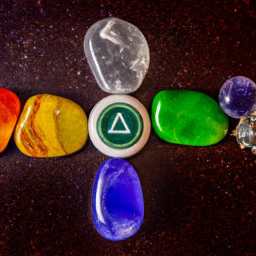
Chakras are the energy centers in our body that are responsible for the flow of energy throughout our system. There are seven major chakras located along the spine, each representing a different aspect of our physical, emotional, and spiritual being. When these energy centers are in balance, we feel a sense of well-being, clarity, and vitality. However, if any of these chakras are blocked or imbalanced, it can lead to physical and emotional issues.
The concept of chakras originates from ancient eastern traditions and has been adopted by many modern spiritual and wellness practices. The word ‘chakra’ comes from Sanskrit, meaning ‘wheel’ or ‘disc’, which reflects the circular movement of energy in these centers. Each chakra is associated with a specific color, element, and mantra, and by understanding the characteristics of each chakra, we can work towards balancing our chakra energy.
1. Root Chakra (Muladhara)
The root chakra is located at the base of the spine and represents our sense of grounding, stability, and security. It is associated with the color red and the element of earth. When this chakra is balanced, we feel connected to our physical body and the earth, and we have a sense of safety and stability in our lives.
To balance the root chakra, you can engage in activities that bring you closer to nature, such as taking a walk in nature, gardening, or even just standing barefoot on the ground. Practicing gratitude, focusing on the present, and incorporating red-colored foods into your diet, such as beets and red apples, can also help in balancing this chakra.
2. Sacral Chakra (Swadhisthana)
The sacral chakra is located just below the navel and is associated with our emotions, creativity, and sensuality. Its color is orange, and its element is water. When this chakra is in balance, we feel free to express our emotions and creativity, experience pleasure, and have healthy relationships.
Activities like dancing, painting, or engaging in any form of creativity can help balance this chakra. Surrounding yourself with the color orange and incorporating water into your daily routine, such as taking a bath or swimming, can also be beneficial.
3. Solar Plexus Chakra (Manipura)
The solar plexus chakra is located above the navel and is associated with our personal power, self-esteem, and confidence. Its color is yellow, and its element is fire. A balanced solar plexus chakra allows us to have a strong sense of self-worth and assertiveness.
Engaging in physical exercise, especially core-strengthening activities, can help balance this chakra. Practicing positive self-talk and setting boundaries also contribute to balancing the solar plexus chakra. Eating yellow-colored foods, such as bananas and yellow peppers, can also have a positive impact.
4. Heart Chakra (Anahata)
The heart chakra is located in the center of the chest and is associated with love, compassion, and forgiveness. Its color is green, and its element is air. A balanced heart chakra allows us to give and receive love freely, have healthy relationships, and feel a sense of peace.
Meditation, yoga, and deep breathing exercises can help balance the heart chakra. Expressing gratitude and practicing acts of kindness and compassion towards others also contribute to balancing this chakra. Eating green-colored foods, such as leafy vegetables and avocados, can also aid in balancing the heart chakra.
5. Throat Chakra (Vishuddha)
The throat chakra is located in the throat and is associated with communication, self-expression, and truth. Its color is blue, and its element is ether. A balanced throat chakra allows us to speak our truth, express ourselves authentically, and effectively communicate with others.
Singing, chanting, or practicing throat-opening yoga poses can help balance the throat chakra. Writing, journaling, or engaging in any form of creative expression through the written word can also be beneficial. Eating blue-colored foods, such as blueberries and blue potatoes, can also contribute to balancing this chakra.
6. Third Eye Chakra (Ajna)
The third eye chakra is located in the center of the forehead and is associated with intuition, imagination, and wisdom. Its color is indigo, and its element is light. A balanced third eye chakra allows for clear thinking, inner wisdom, and the ability to trust our intuition.
Meditation, visualization, and spending time in silence can help balance the third eye chakra. Activities that stimulate the imagination, such as reading, painting, or even daydreaming, can also contribute to balancing this chakra. Eating indigo-colored foods, such as purple cabbage and eggplant, can also have a positive impact.
7. Crown Chakra (Sahasrara)
The crown chakra is located at the top of the head and is associated with spirituality, enlightenment, and connection to the divine. Its color is violet or white, and its element is thought. A balanced crown chakra allows us to experience a deep sense of peace and connection to something greater than ourselves.
Practicing mindfulness, spending time in nature, and engaging in activities that bring a sense of awe and wonder, such as stargazing, can help balance the crown chakra. Eating white-colored foods, such as cauliflower and garlic, can also aid in balancing this chakra.
Final Thoughts
Understanding and balancing our chakras is an important aspect of maintaining our overall well-being. By incorporating practices that align with each chakra’s characteristics and incorporating foods of corresponding colors into our diet, we can work towards achieving balance and harmony in our chakra energy. Remember, a balanced chakra system leads to a balanced and harmonious life!
“The key to a healthy and happy life is finding balance in all aspects of our being – physical, emotional, and spiritual.”





Wow, this looks awesome!
MaxDaGoodGuy: Definitely worth a try! #balancemychakrasenergy
Great idea! I’m looking forward to seeing the results!